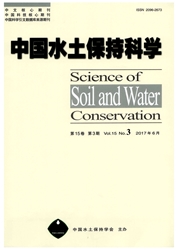

 中文摘要:
中文摘要:
为了研究福建三明地区火烧迹地杉木人工林地的土壤速效养分变化,采用调查取样和室内分析相结合的方法,对上、中和下3个坡位的土壤,分别在火烧前、火烧2个月、1年和2年后,分析速效性养分质量分数的变化。结果表明:硝态氮质量分数在火烧2个月和1年后相比火烧前均有上升趋势,且火烧1年内,上坡位较中坡位和下坡位的硝态氮质量分数要低,在火烧2年后硝态氮质量分数略低于火烧前水平,但未达到显著差异;铵态氮质量分数与硝态氮质量分数的变化趋势相反,在火烧的第1年内持续下降,但在火烧第2年后显著升高;不同时间的速效磷质量分数,在不同坡位间无显著差异,火烧的第1年内,其质量分数变化不明显,在火烧2年后显著升高,这可能是土壤矿化速度加快造成的结果;无机氮/速效磷比值在火烧2年后显著降低,速效磷质量分数剧增是影响其比值的主要因素。火烧在短期内,加快了土壤速效性养分循环,但要注意可能造成氮素从森林生态系统中流失。研究以期为火烧对土壤养分的长期影响提供数据基础,为森林生态系统火烧迹地的人工林经营,提供科学的理论依据。
 英文摘要:
英文摘要:
[ Background] Fire is a controlling factor in terrestrial ecosystems. Moderate frequency and intensity of fire can be beneficial for the structure and functioning of ecosystems, thereby maintaining forest biodiversity and nutrient cycling, and improving soil fertility in forest ecosystems. [ Methods] Field investigations and lab analyses were conducted to study the effects of slash burning on soil nutrients on the clear-cutting sites of Cunninghamia lanceolata plantation. Three slope locations (i. e. upper slope, middle slope and lower slope locations) were selected to monitor the dynamic changes in soil available nutrient status, including nitrate nitrogen ( NO3--N) , ammonium nitrogen ( NH4+-N) and available phosphorus ( A-P). The soil samples were collected one time before the burning and three times after the burning (i. e. 2 months, 1 year, and 2 years). The changes of soil available nutrient on different recovery times and slope locations were examined. [ Results] 1 ) The concentration of NO3--Nincreased in the second month and the first year after the burning but declined slightly in the second year, in comparison with that prior to the burning. Additionally, the concentration of NO3--N in upper slope location was lower than those in other slope locations within a year of burning. The averaged concentration of soil NO/-N from different fire time exhibited the following trend: the first year of burning (27.53mg/ kg) 〉 the second month of burning (26.03 mg/kg) 〉 before the burning (22.32 mg/kg) 〉 the second year of burning (15.33 mg/kg). 2) By contrast, the concentration of NH4+ -N showed an opposite trend: declining within the first year from 11.52 mg/kg (before the burning) to 8.48 mg/kg (the second month of burning) and 5.19 mg/kg (the first year of burning). However, it increased significantly after the second year of burning, reaching 8.99 mg/kg. 3) There was no significant difference in A- P concentration among different slope location
 同期刊论文项目
同期刊论文项目
 同项目期刊论文
同项目期刊论文
 期刊信息
期刊信息
